MICROSOFT NEWS: 70-459 Exam Questions has been Updated Today! Get Latest 70-459 VCE and 70-459 Book Instantly! Welcome to Download the Newest Braindump2go 70-459 VCE&70-459 PDF Dumps: http://www.braindump2go.com/70-459.html (125 Q&As)
Quick and Effective Microsoft 70-459 Exam Preparation Options – Braindump2go new released 70-459 Exam Dumps Questions! Microsoft Official 70-459 relevant practice tests are available for Instant downloading at Braindump2go! PDF and VCE Formates, easy to use and install! 100% Success Achievement Guaranteed!
Exam Code: 70-459
Exam Name: Transition Your MCITP: Database Administrator 2008 or MCITP: Database Developer 2008 to MCSE: Data Platform
Certification Provider: Microsoft
Corresponding Certifications: MCP, MCSA, MCSE
70-459 Dump,70-459 PDF,70-459 VCE,70-459 Braindump,70-459 Book,70-459 Certification,70-459 Exam Dumps,70-459 Exam Questions,70-459 eBook,70-459 Practice Exam,70-459 Practice Test,70-459 Preparation,70-459 Study Guide,70-459 Study Material,70-459 Training Kit
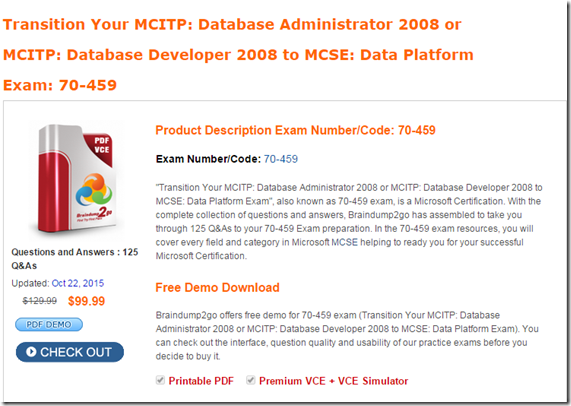
QUESTION 71
You need to modify usp_SelectSpeakersByName to support server-side paging.
The solution must minimize the amount of development effort required.
What should you add to usp_SelectSpeakersByName?
A. a table variable
B. an OFFSET-FETCH clause
C. the ROWNUMBER keyword
D. a recursive common table expression
Answer: B
Explanation:
http://www.mssqltips.com/sqlservertip/2696/comparing-performance-for-different-sql-server-paging-methods/
http://msdn.microsoft.com/en-us/library/ms188385.aspx
http://msdn.microsoft.com/en-us/library/ms180152.aspx
http://msdn.microsoft.com/en-us/library/ms186243.aspx
http://msdn.microsoft.com/en-us/library/ms186734.aspx
http://www.sqlserver-training.com/how-to-use-offset-fetch-option-in-sql-server-order-by-clause/-
http://www.sqlservercentral.com/blogs/juggling_with_sql/2011/11/30/using-offset-and-fetch/
Case Study 7 – Invoice Scehma Scenario (QUESTION 72 ~ QUESTION 78)
Application Information
Your company receives invoices in XML format from customers.
Currently, the invoices are stored as files and processed by a desktop application.
The application has several performance and security issues.
The application is being migrated to a SQL Server-based solution.
A schema named InvoiceSchema has been created for the invoices xml.
The data in the invoices is sometimes incomplete.
The incomplete data must be stored and processed as-is.
Users cannot filter the data provided through views.
You are designing a SQL Server database named DB1 that will be used to receive, process, and securely store the invoice data.
A third-party Microsoft .NET Framework component will be purchased to perform tax calculations. The third-party tax component will be provided as a DLL file named Treytax.dll and a source code file named Amortize.cs.
The component will expose a class named TreyResearch and a method named Amortize().
The files are located in c:\temp\.
The following graphic shows the planned tables:

You have a sequence named Accounting.InvoiceID_Seq.
You plan to create two certificates named CERT1 and CERT2.
You will create CERT1 in master.
You will create CERT2 in DB1.
You have a legacy application that requires the ability to generate dynamic T-SQL statements against DB1.
A sample of the queries generated by the legacy application appears in Legacy.sql.
Application Requirements
The planned database has the following requirements:
– All stored procedures must be signed.
– The original XML invoices must be stored in the database.
– An XML schema must be used to validate the invoice data.
– Dynamic T-SQL statements must be converted to stored procedures.
– Access to the .NET Framework tax components must be available to T-SQL objects.
– Columns must be defined by using data types that minimize the amount of space used by each table.
– Invoices stored in the InvoiceStatus table must refer to an invoice by the same identifier used by the Invoice table.
– To protect against the theft of backup disks, invoice data must be protected by using the highest level of encryption.
– The solution must provide a table-valued function that provides users with the ability to filter invoices by customer.
– Indexes must be optimized periodically based on their fragmentation by using the minimum amount of administrative effort.
Usp_InsertInvoices.sql
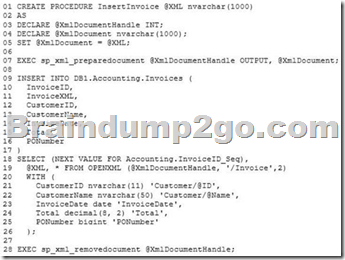
Invoices.xml
All customer IDs are 11 digits. The first three digits of a customer ID represent the customer’s country. The remaining eight digits are the customer’s account number.
The following is a sample of a customer invoice in XML format:

InvoicesByCustomer.sql

Legacy.sql

CountryFromID.sql
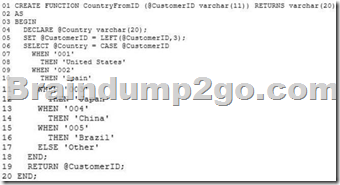
IndexManagement.sql

QUESTION 72
You need to modify the function in CountryFromID.sql to ensure that the country name is returned instead of the country ID.
Which line of code should you modify in CountryFromID.sql?
A. 404
B. 06
C. 19
D. 05
Answer: C
Explanation:
http://msdn.microsoft.com/en-us/library/ms186755.aspx
http://msdn.microsoft.com/en-us/library/ms191320.aspx
QUESTION 73
Which data type should you use for CustomerlD?
A. varchar(11)
B. bigint
C. nvarchar(11)
D. char(11)
Answer: D
Explanation:
Invoices.xml
All customer IDs are 11 digits. The first three digits of a customer ID represent the customer’s country. The remaining eight digits are the customer’s account number.
int: -2^31 (-2,147,483,648) to 2^31-1 (2,147,483,647) (just 10 digits max) bigint: -2^63 (-9,223,372,036,854,775,808) to 2^63-1 (9,223,372,036,854,775,807)
http://msdn.microsoft.com/en-us/library/ms176089.aspx
http://msdn.microsoft.com/en-us/library/ms187745.aspx
QUESTION 74
You have a SQL Server 2012 database named database1.
Database1 has a data file named databasel_data.mdf and a transaction log file named databaseljog.ldf. Databasel_data.mdf is 1.5 GB. Databaseljog.ldf is 1.5 terabytes.
A full backup of Database1 is performed every day.
You need to reduce the size of the log file.
The solution must ensure that you can perform transaction log backups in the future.
Which code segment should you execute? To answer, move the appropriate code segments from the list of code segments to the answer area and arrange them in the correct order.

A. Option A
B. Option B
C. Option C
D. Option D
E. Option E
F. Option F
Answer: ACDE
QUESTION 75
You need to modify InsertInvoice to comply with the application requirements.
Which code segment should you execute?
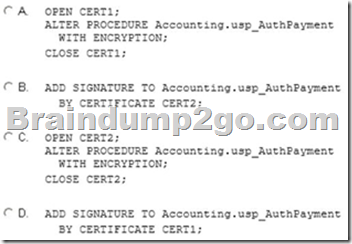
A. Option A
B. Option B
C. Option C
D. Option D
Answer: B
Explanation:
http://msdn.microsoft.com/en-us/library/bb669102.aspx
QUESTION 76
You need to convert the functionality of Legacy.sql to use a stored procedure.
Which code segment should the stored procedure contain?

A. Option A
B. Option B
C. Option C
D. Option D
Answer: D
Explanation:
http://msdn.microsoft.com/en-us/library/ms187926.aspx
http://msdn.microsoft.com/en-us/library/ms190782.aspx
http://msdn.microsoft.com/en-us/library/bb669091.aspx
http://msdn.microsoft.com/en-us/library/windows/desktop/ms709342.aspx http://msdn.microsoft.com/en-us/library/ms188001.aspx
QUESTION 77
Drag and Drop Question
You need to build a stored procedure thatamortizes the invoice amount.
Which code segment should you use to create the stored procedure? To answer, move the appropriate code segments from the list of code segments to the answer area and arrange them in the correct order.
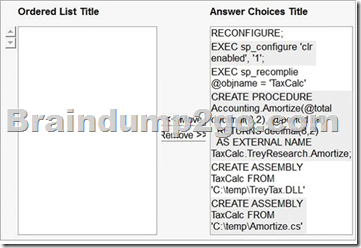
Answer:

Explanation:
http://msdn.microsoft.com/en-us/library/ms131089.aspx
http://msdn.microsoft.com/en-us/library/ms131048.aspx
http://msdn.microsoft.com/en-us/library/ms187926.aspx
QUESTION 78
You need to prepare the database to use the .NET Framework tax component.
Which code segments should you execute? (Each correct answer presents part of the solution. Chooseall that apply.)
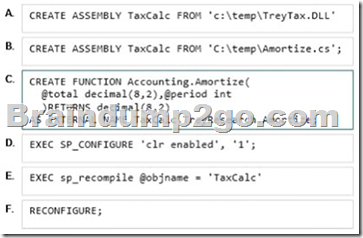
A. Option A
B. Option B
C. Option C
D. Option D
E. Option E
F. Option F
Answer: ACDE
Case Study 8 – Fourth Coffee (QUESTION 79 ~ QUESTION 93)
Background
Corporate Information
Fourth Coffee is global restaurant chain. There are more than 5,000 locations worldwide.
Physical Locations
Currently a server at each location hosts a SQL Server 2012 instance. Each instance contains a database called StoreTransactions that stores all transactions from point of sale and uploads summary batches nightly.
Each server belongs to the COFFECORP domain. Local computer accounts access the StoreTransactions database at each store using sysadmin and data reader writer roles.
Planned Changes
Fourth Coffee has three major initiatives:
– The IT department must consolidate the point of sales database infrastructure.
– The marketing department plans to launch a mobile application for micropayments.
– The finance department wants to deploy an internal tool that will help detect fraud.
Initially, the mobile application will allow customers to make micropayments to buy coffee and other items on the company web site. These micropayments may be sent as gifts to other users and redeemed within an hour of ownership transfer. Later versions will generate profiles based on customer activity that will push texts and ads generated by an analytics application.
When the consolidation is finished and the mobile application is in production, the micropayments and point of sale transactions will use the same database.
Existing Environment
Existing Application Environment
Some stores have been using several pilot versions of the micropayment application.
Each version currently is in a database that is independent from the point of sales systems.
Some versions have been used in field tests at local stores, and others are hosted at corporate servers. All pilot versions were developed by using SQL Server 2012.
Existing Supporting Infrastructure
The proposed database for consolidating micropayments and transactions is called Coffee Transactions.
The database is hosted on a SQL Server 2014 Enterprise Edition instance and has the following file structures:
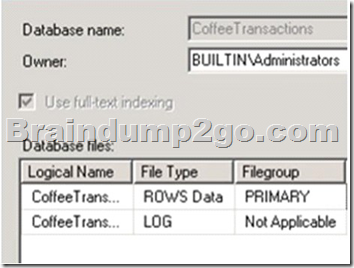
Business Requirements
General Application Solution Requirements
The database infrastructure must support a phased global rollout of the micropaymentapplication and consolidation.
The consolidated micropayment and point of sales database will be into a Coffee Transactions database.
The infrastructure also will include a new Coffee Analytics database for reporting on content from Coffee Transactions.
Mobile applications will interact most frequently with the micropayment database for the following activities:
– retrieving the current status of a micropayment
– modifying the status of the current micropayment;
– and canceling the micropayment.
The mobile application will need to meet the following requirements:
– Communicate with web services that assign a new user to a micropayment by using a stored procedure named usp_AssignUser.
– Update the location of the user by using a stored procedure namedusp_AddMobileLocation.
The fraud detection service will need to meet the following requirements:
– Query the current open micropayments for users who own multiple micropayments by using a stored procedure named usp_LookupConcurrentUsers.
– Persist the currentuser locations by using a stored procedure named usp.MobileLocationSnapshot.
– Look at the status of micropayments and mark micropayments for internal investigations.
– Move micropayments to dbo.POSException table by using a stored procedure named ups_DetectSuspiciousActivity.
The Coffee Analytics database will combine imports of the POSTransaction and Mobile Location tables to create a UserActivity table for reports on the trends in activity. Queries against the UserActivity table will include aggregated calculations on all columns that are not used in filters or groupings.
Micropayments need to be updated and queried for only a week after their creation by the mobile application or fraud detection services.
Performance
The most critical performance requirement is keeping the response time for any queries of the POSTransaction table predictable and fast.
Web service queries will take a higher priority in performance tuning decisions over the fraud detection agent queries.
Scalability
Queries of the user ofa micropayment cannot return while the micropayment is being updated, but can show different users during different stages of the transaction.
The fraud detection service frequently will run queries over the micropayments that occur over different time periods that range between 30 seconds and ten minutes.
The POSTransaction table must have its structure optimized for hundreds of thousands of active micropayments that are updated frequently.
All changes to the POSTransaction table will require testing inorder to confirm the expected throughput that will support the first year’s performance requirements.
Updates of a user’s location can tolerate some data loss.
Initial testing has determined that the POSTransaction and POSException tables will be migrated to an in-memory optimized table.
Availability
In order to minimize disruption at local stores during consolidation, nightly processes will restore the databases to a staging server at corporate headquarters.
Technical Requirements
Security
The sensitive nature of financial transactions in the store databases requires certification of the COFFECORP\Auditors group at corporate that will perform audits of the data. Members of the COFFECORP\Auditors group cannot have sysadmin or datawriter access to the database.
Compliance requires that the data stewards have access to any restored StoreTransactions database without changing any security settings at a database level.
Nightly batch processes are run by the services account in the COFFECORP\StoreAgent group and need to be able to restore and verify the schema of the store databases match.
No Windows group should have more access to store databases than is necessary.
Maintainability
You need to anticipate when POSTransaction table will need index maintenance.
When the daily maintenance finishes, micropayments that are one week old must be available for queries in UserActivity table but will be queried most frequently within their first week and will require support for in-memory queries for data withinfirst week.
The maintenance of the UserActivity table must allow frequent maintenance on the day’s most recent activities with minimal impact on the use of disk space and the resources available to queries. The processes that add data to the UserActivitytable must be able to update data from any time period, even while maintenance is running.
The index maintenance strategy for the UserActivity table must provide the optimal structure for both maintainability and query performance.
All micropaymentsqueries must include the most permissive isolation level available for the maximum throughput.
In the event of unexpected results, all stored procedures must provide error messages in text message to the calling web service.
Any modifications to stored procedures will require the minimal amount of schema changes necessary to increase the performance.
Performance
Stress testing of the mobile application on the proposed Coffee Transactions database uncovered performance bottlenecks. The sys.dm_os_wait_stats Dynamic Management View (DMV) shows high wait_time values for WRTTELOG and PAGEIOLATCHJJP wait types when updating the MobileLocation table.
Updates to the MobileLocation table must have minimal impact on physical resources.
Supporting Infrastructure
The stored procedure usp_LookupConcurrentUsers has the current implementation:

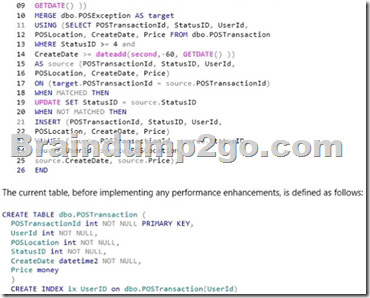
QUESTION 79
You need to monitor the health of your tables and indexes in order to implement the required index maintenance strategy.
What should you do?
A. Query system DMVs to monitor avg_chain_length and max_chain_length.
Create alerts to notify you when these values converge.
B. Create a SQL Agent alert when the File Table:
Avg time per file I/O request value is increasing.
C. Query system DMVs to monitor total_bucket_count.
Create alerts to notify you when this value increases.
D. Query system DMVs to monitor total_bucket_count.
Create alerts to notify you when this value decreases.
Answer: A
Explanation:
From scenario:
* You need to anticipate when POSTransaction table willneed index maintenance.
* The index maintenance strategy for the UserActivity table must provide the optimal structure for both maintainability and query performance.
QUESTION 80
Drag and Drop Question
You need to implement a new version of usp_AddMobileLocation.
Develop the solution by selecting and arranging the required code blocks in the correct order.
You may not need all of the code blocks.
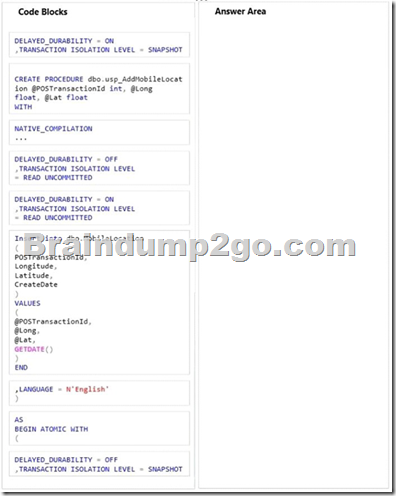
Answer:
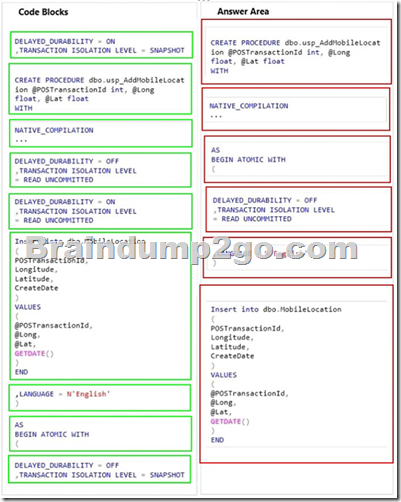
100% Full Money Back Guarantee Promised By Braindump2go to All 70-459 Exam Candiates: Braindump2go is confident that our NEW UPDATED 70-459 Exam Questions and Answers are changed with Microsoft Official Exam Center, If you cannot PASS 70-459 Exam, nevermind, we will return your full money back! Visit Braindump2go exam dumps collection website now and download 70-459 Exam Dumps Instantly Today!
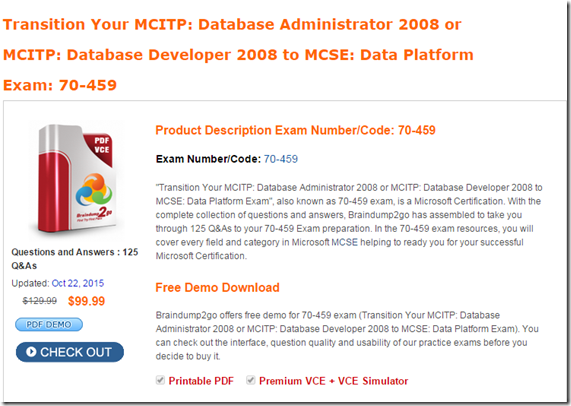
FREE DOWNLOAD: NEW UPDATED 70-459 PDF Dumps & 70-459 VCE Dumps from Braindump2go: http://www.braindump2go.com/70-459.html (125 Q&A)